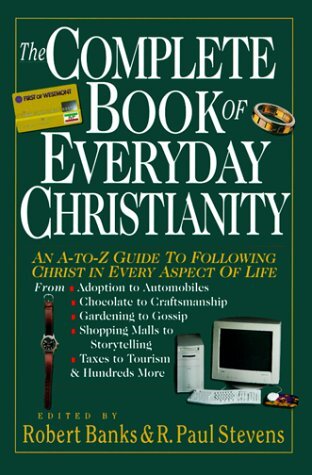Imagination
Book / Produced by partner of TOW
All of us know the parable of the rich man and Lazarus in Luke 16:19-31. Many sermons interpret the story as referring only to how people will respond to Jesus’ death and resurrection. But all good stories have layers or levels of meaning, and this one is no exception. For instance, the story of Lazarus concerns justice, welfare, community, responsibility, the proper distribution of wealth and a host of other issues that reverberate with social and political implications. But here is another interpretation. The story of Lazarus is a story that defines imagination by its opposite: imagination failed, unexercised, atrophied.
Imagination: The Organ of Meaning
The rich man could not imagine a life that included homeless people or people to whom he owed compassion or help. He could not envision an eternity of fire and thirst and anguish. Then, when he was finally in the middle of his eternal bad situation and wanted to help his brothers, he could not imagine failure. But Abraham knew that the five brothers each had an imagination no more active than the one the rich man had. They lacked, as C. S. Lewis would say, the “organ of meaning” (p. 265). They could not hear, see, touch, taste, smell or even think with their imagination. Not that they were born without an imagination; no one is. But they lacked practice in using imagination.
In Through the Looking Glass Lewis Carroll gives us a different take on the story of Lazarus. The White Queen is speaking to Alice.
“I can’t believe that,” said Alice.
“Can’t you?” the Queen said, in a pitying tone. “Try again: draw a long breath and shut your eyes.”
Alice laughed. “There’s no use trying,” she said: “one can’t believe impossible things.”
“I daresay you haven’t had much practice,” said the Queen.“When I was your age, I always did it for half-an-hour a day. Why, sometimes I’ve believed as many as six impossible things before breakfast.” (Carroll, p. 251)
There are a lot of Alices in the Bible and a lot today. I have often been one myself. Alice-types have no ears, to use Jesus’ term. They refuse to exercise the organ they were born with. And imagination is as important, as essential, an organ as the heart, the lungs, the liver. I might even go so far as to make an extravagant claim and say that imagination is even more important, because without it there is no point in the heart’s pumping and the lungs’ bellowing. To live we need more than the basic physiological requirements. We need meaning and the means to find meaning. Enter imagination.
Let me repeat what C. S. Lewis says about imagination in “Bluspels and Flalansferes.” He claims that “reason is the natural organ of truth; imagination is the natural organ of meaning” (p. 265). He makes these two statements equal, syntactically as well as semantically. It is not enough, Lewis is claiming, to have reason; we also need imagination, for without it we do not have a clue as to what truth means.
Lewis’s claim is deceptively simple and, like all deceptively simple statements, hard to explain. One thing is certain. It is not enough in life for us to have facts, data, information—the stuff we are inundated with in our culture. We need to know purpose, intention, implication, possible consequences, multiple perspectives. We need to live imaginatively.
How do we do this? How do we understand imagination? We do so with imagination itself, with imagination in action. But to understand something using the very thing you are trying to understand presents great difficulties. In that way imagination is rather like language, which is intimately related to defining and using imagination. Or imagination is like the Incarnation. As that great rhetorician and theologian Saint Augustine said about Jesus, he is both the destination and the road to the destination. So with imagination—it is the object we study and the tool we use in order to study it. For the moment, though, it is enough to say that imagination provides ways of seeing, and so living, life.
Imagination and Metaphor
With all that in mind—in imagination, if you will—I would like to quote the Bible, specifically Psalms, though I could use some of Jesus’ parables or Paul’s letters.
He is like a tree planted by streams of water,
which yields its fruit in season
and whose leaf does not wither. (Psalm 1:3)
They are like chaff
that the wind blows away. (Psalm 1:4)
You are a shield around me, O Lord. (Psalm 3:3)
Strike all my enemies on the jaw;
break the teeth of the wicked. (Psalm 3:7)
He who is pregnant with evil
and conceives trouble gives birth to disillusionment. (Psalm 7:14)
The heavens declare the glory of God;
the skies proclaim the work of his hands.
Day after day they pour forth speech;
night after night they display knowledge. (Psalm 19:1-2)
A pattern begins to emerge—a pattern of imagination and a central, indeed a fundamental, function of imagination. We could call it image-making or metaphor making. We could call it part of rhetoric, that ancient art which Augustine so ably defended in On Christian Doctrine.
In metaphor we use one object to understand another—even if the two objects appear to have nothing in common. That is the tricky part of metaphor, which is like an unexpected and unpredictable equation, an odd, quirky a = b. To understand a, so the metaphor maker claims, we need to figure out b, and vice versa. We need to think about the characteristics of each object. Then we need to ask what the two objects might possibly have in common. For instance, what do the heavens have to do with a garrulous group of people? Or what does the Christian community have to do with vines and branches? But first ask, how do vines and branches grow? What are the roots like? What about the branches? What happens when a vine wants or needs to climb? What does it look for? Once we have answered such questions, then we can begin to understand what the metaphor tells us about the characteristics of a Christian’s relationship to Jesus or how Christians should relate to one another. One object or idea is described in comparison to or with something else.
In the psalms we find such nature metaphors: good people compared to fruitful trees (Psalm 1:3), wicked people to chaff (Psalm 1:4). Most of us know what a ripe tree looks and smells like, and some of us, at least, know what chaff feels like—its stiff, cutting edges, its lack of weight. Strip the wheat and what remains has no meaning—no function, no use. So the psalmist is saying that though wicked people may cut or injure, ultimately they are impotent. In other words, they are not human.
On the other hand, imagine this from Psalm 7:14: evil people are pregnant, giving birth to disillusionment—a feminine metaphor as well as a genetic one. John Milton must have known this passage well, for he uses a similar idea in his great epic, Paradise Lost. When I read this psalm, I picture the character Disillusionment roaming the cities, wandering around the country, spreading a malaise, an angst, a depression that the citizenry cannot seem to fight—this sounds a lot like our own time.
We are all familiar with the metaphors of God as shield, warrior, fortress and so forth. The Old Testament, in particular, is filled with masculine, military metaphors. In the passage where God breaks the teeth of the wicked (Psalm 3:7), the metaphor provides a specific picture—God as boxer or foot soldier. He has personally taken on that pregnant enemy. Metaphors, then—or imagination—make concrete what might only be an abstract idea. To say God will protect you, as true as that might be, is not nearly as strong as saying God is going to hand your enemy the one-two punch. No one could ever accuse the psalmist of lacking imagination.
So far I have claimed that imagination is biblical—as we see from Jesus’ storytelling and the psalms. I have claimed that we are born with at least the possibility of imagination, if only metaphorically speaking. Although I have not used the Latin phrase imago Dei,it has been lurking beneath my words all along. Imagination is the image of God in us. As J. R. R. Tolkien, among others, has said, we make because God makes. I have also said that imagination and language go hand in hand. And finally I have claimed that without imagination we understand nothing.
The Biology of Imagination
These claims come from philosophical, theological and aesthetic perspectives. Now I want to turn to the physiological or neurological level. It appears from the latest research into how the brain functions that imagination is an essential part of our neurological makeup. We are, quite literally, hard-wired in the image of God. Just as language is inevitable, given normal circumstances, so is imagination. And even when things go astray—say with autism or frontal lobe damage—people still appear to have an imagination, albeit of a different kind, even when they do not have much else, even language. None of us can fully function—can actually consider ourselves human—without imagination. We find evidence for this in several places: in studies of memory, in the way cells grow, in the biological nature of play and joy.
First, let us consider memory. Without imagination we could not remember. And if we could not remember, then what? How would we form relationships with people or communities? How would we be able to grieve, laugh, cry, tell stories, participate in all the small and great rituals and celebrations that mark a life? Think, if you will, of a graduation, a wedding, a funeral. Had you no memory, what meaning would a graduation have? Would it matter that your son or daughter, your sister or brother—or even you yourself—was leaving high school for college or college for a career? What difference would it make to attend the wedding of the daughter or son of an old friend? Would you even have an old friend to begin with? No, because you would not have any concept of old at all. And without a concept of old—or of before—you would not have any concept of new—or after. We know people whose memory is not much; we probably know people whose memory has begun to fail or fade. Think of the terror of Alzheimer’s—terror for the person who knows at first that he or she will soon have no memory—but the greater anguish is that of the people who still do remember, the friends and relatives of the Alzheimer’s victim.
Of course, without memory many other normal human experiences would be denied us—learning, reading, watching films, even worship. What would Easter or Christmas mean? Pentecost? or Sundays? Oliver Sacks in An Anthropologist on Mars: Seven Paradoxical Tales quotes Eva Brann, the philosopher, as calling memory “the storehouse of the imagination” (p. 176). Notice the metaphor—storehouse, a place where farmers put grain, food. So Brann is saying that memory feeds imagination. She encourages us, in Sacks’s words, to “see memories as imaginative, as creative, from the start,” for
Imaginative memory not only stores for us the passing moments of perception; it also transfigures, distances, vivifies, defangs—reshapes formed impressions, turns oppressive immediacies into wide vistas . . . loosens the rigid grip of an acute desire and transforms it into a fertile design. (Sacks, p. 176)
Brann’s description sounds like the work of the healing, life-giving, life-transforming God for whom there are no mistakes, castoffs or leftovers among people, as the stories Sacks tells remind us. And each of Brann’s verbs is a metaphor, reinforcing the view that we cannot know or explain our knowing without imagination.
Just as we need imagination, then, for a full, healthy exercise of our memory, how we remember indicates the inborn nature of imagination. Cellular biologists provide another piece of evidence for the physiological understanding of imagination. One of the characteristics of imagination, imitation or mimicry appears to be built into the way life begins. In The Beauty of the Beastly science writer Nancy Angier explains Hox genes by noting that “the embryo is constructed as a whole series of repetitious segments: the new section of the body grows out as a mimic of the portion preceding it, and variations are subsequently added to each section to lend the final body its complexity of parts” (p. 85). Her description is reminiscent of a composition with theme and variation or with Tolkien’s notion that we are subcreators with God as the original Creator. There is a marvelous elegance of design in the biology of imagination.
Angier also explores the biological base for laughter and joy. Play, for instance, appears to help the brain grow, thus providing a reason children need to play, why imagination is crucial for full development. In addition, for reasons still unclear to biologists, joy—unadulterated happiness—helps the body heal or even prevent illness: “[Researchers] suspect . . . that sensations like optimism, curiosity and rapture—the giddy, goofy desire to throw the arms wide and serenade the sweetness of spring—not only make life worth living but make life last longer” (p. 194). Although she calls optimism, curiosity and rapture “sensations,” clearly these are characteristics of imagination, particularly curiosity.
If imagination is part of our immune system, part of our cellular structure, part of the structure of the brain itself, then it is fundamental to life. We do indeed need imagination. But what else does imagination affect? We need it for many if not all of our sensory perceptions—color, smell, touch, shape, visual perception, hearing. When the man born blind and healed by Jesus says that he saw men as trees, walking, two things are going on. First, the man uses a simile—metaphoric language, the work of imagination. Second, he is telling us that his visual perceptions, his visual imagination, needs some practice. We learn to see, and we learn it early. We can also forget how to see. And those born blind have never learned. To the man born blind, a man appeared like a tree; he had not yet learned what a man looked like. Not that he knew what a tree looked like either; rather, he was speculating, conjecturing, imagining, based on what he had been told, that men were like trees—upright, had limbs, could bend and so forth (for a further discussion of how the blind use visual metaphors, see Dennett, p. 55). So blindness is not simply physiological but imaginative and cognitive.
Sometimes we cannot see the forest for the trees, the whole for the confusing parts. For the newly sighted—or the newly hearing—this is overwhelmingly true. When Isaiah promises that the ears of the deaf will open, the tongues of the dumb loosen up and the eyes of the blind see, he is making a physiological, neurological and imaginative promise. The miracles of God, then, are far richer than we imagine and far more imaginative as well.
We could not get through a day, much less a lifetime, without using imagination. We could not sit in a chair, lift a fork, light a candle or kneel to pray. Although painters, writers, architects, city planners or psychiatrists may be more conscious of imagination than we are, we cannot function at even the most basic level without imagination.
Living Imaginatively
Why should we settle for uninformed, unaware or automatic imaginative living? Why should we not practice our imagination as fully as we are able? There is much we can do, though we may not always realize it.
To begin, we can read as a way to stimulate curiosity (see Reading). We can also relearn how to see, just as the man born blind had to relearn visual perceptions. Let me quote again from Sacks, writing about a man who after a cataract operation was seeing for the first time since he was quite young: “As Virgil explored the rooms of his house, investigating, so to speak, the visual construction of the world, I was reminded of an infant moving his hand to and fro before his eyes, waggling his head, turning it this way and that, in his primal construction of the world” (p. 127). As all parents know, every normal baby does this, every one. Sacks continues:
Most of us have no sense of the immensity of this construction, for we perform it seamlessly, unconsciously, thousands of times every day, at a glance. But this is not so for a baby, it was not so for Virgil, and it is not so for, say, an artist who wants to experience his elemental perceptions afresh and anew. (p. 127)
That last phrase is crucial—“an artist who wants to experience his elemental perceptions afresh and anew.” Part of daily imaginative living could well involve practicing what visual artists do.
Occasionally, when one of my writing classes is dragging, I will ask students to go outside or stare out the window and notice every tiny thing they can. “What do you see?” I ask. At first they tell me obvious things—a brick wall, a plant, sky, clouds, people. And with each answer I ask, “And what else?” Usually we stop long before we should, for I do not recall any student getting to things like cones, triangles, squares, a hypotenuse—and yet we are surrounded by geometry. Few students notice the multiple shades of green, blue, white or tan or the various textures from rough to smooth and everything in between. Paul Cézanne once wrote, “The same subject seen from a different angle gives a subject for study of the highest interest and so varied that I think I could be occupied for months without changing my place, simply bending more to the right or left” (quoted in Sacks, p. 128). What if we did this with some object—a refrigerator, a tennis racquet, a pair of shoes? Or what if we did this with a person? an idea? a too-favorite Bible passage?
People who live imaginative lives are “what if” people. They respond to ideas and events with a “what if” attitude. They behave in “what if” ways. “What if” is a big idea, as big as God, for it is the practice of God. God thinks: What if I gave this guy named Mozart musical ability? Or what if I gave this Dutchman a passion for paint, for light and shadow? Or this woman a love of fabric or yarn or test tubes? What if that person over there had a fondness for order and pattern? What if you loved numbers—or flour and yeast? What if you would like to smell dirt on your hands or crushed herbs, peonies or lilacs? Or machine oil?
These, however, as good as they are, are “what if” ideas that center on the self. Imaginative living—true Christ-bearing, imaginative living—means going beyond the self. For instance, I know a professor at a Christian college who volunteers hours a week to spend with AIDS patients. Others read to the blind, become friends with lonely old people whose families ignore them, work in co-ops or in adult literacy programs, help organic farmers, resist developers. All these people are practicing “what if” living by using their imagination in empathic ways.
Every time we say “what if” or act in a “what if” way, we respond as creatures made in the image of the Creator—from the great imagination to our own.
» See also: Art
» See also: Beauty
References and Resources
N. Angier, The Beauty of the Beastly: New Views of the Nature of Life (Boston: Houghton Mifflin, 1995); L. Carroll, The Annotated Alice: Alice’s Adventure in Wonderland and Through the Looking Glass, with introduction and notes by M. Gardner (New York: Wings Books, 1960); D. C. Dennett, Consciousness Explained (Boston: Little, Brown, 1991); C. Forbes, Imagination: Embracing a Theology of Wonder (Portland, Ore.: Multnomah, 1986); C. A. Huttar, ed., Imagination and the Spirit: Essays in Literature and the Christian Faith Presented to Clyde S. Kilby (Grand Rapids: Eerdmans, 1971); C. S. Lewis, “Bluspels and Flalansferes,” in Selected Literary Essays, ed. W. Hooper (Oxford: Oxford University Press, 1969); O. Sacks, An Anthropologist on Mars: Seven Paradoxical Tales (New York: Knopf, 1995).
—Cheryl Forbes





